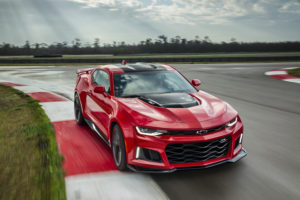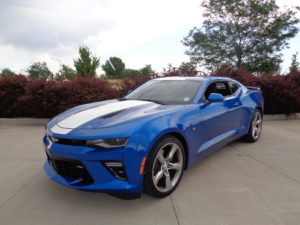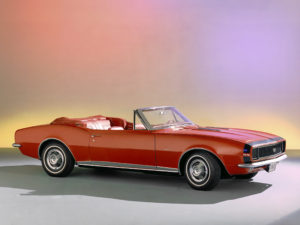
Fifty years to the month after the Camaro was revealed to the public, Chevrolet will commemorate the muscle car’s 50th anniversary celebration during the Woodward Dream Cruise in Detroit.
Celebration and tours of the Lansing Grand River plant in Lansing, Mich., where the Camaro is built, are planned for Thursday, Aug. 18, and Chevrolet’s Woodward Dream Cruise on Saturday, Aug. 20, will include rare and milestone examples from the Camaro’s six generations, including the all-new 2017 Camaro ZL1 and 1LE models.
It was in mid-August 1966 that the first-produced Camaro was shown to the public, and the much-anticipated Chevy went on sale a month later. To fully appreciate the car’s 50th, forget the fact that the Camaro wasn’t even built from the end of the 2002 model year to the start of ’10 model. It has come back so strong since that it is truly an iconic part of Chevrolet’s more than 100-year history.

In planned recognition of the Camaro’s 50 years, I drove recently the 2016 Camaro 2SS Coupe with its 6.2-liter V-8 of 445 horsepower and 445 torque. Mated to a 6-speed manual transmission, it performs very satisfactorily, with low-throated sound adding emphasis to its acceleration.
Like Chevy’s more spirited Corvette sports car, the SS version of the Camaro offers Active Rev Matching technology, which, engaged by paddles on either side of the steering wheel, blips the throttle to match engine rpm to the wheel speed for a seamless downshift.
The transmission has also General Motors’ long-used “skip-shift” feature, which under normal acceleration will guide the manual shifter from 1st to 4th to save fuel. Yet, a good share of drivers kick up the rpm, which permits a much more rewarding sequence from 1st to 2nd, and saves no fuel.
The Camaro’s exterior, styled in a chopped look, is finished in hyper blue metallic paint, with a white stripe down the middle. Settle into the heavily bolstered sport seat and enjoy not only the performance with its magnetic ride control, but the high-tech audio and navigation systems. Twice while driving I heard the ringing of a phone, pushed the phone-icon button, and once the message center indicated the call was intended for Brian, on a second ringing another day, voice control told me, “You have a call,” then messaged me to “Call Dave at work.”
The Camaro’s driver mode selector offers choice of four custom-tailored styles of performance; I used Sport mode most often, gaining throttle response and steering tightness to my satisfaction. Other modes include Tour, Track and Snow/Ice. If you’re dealing with snow and ice, I’d suggest parking the SS and driving the family crossover.
The Camaro carries an EPA fuel-mileage rating of 16/25 miles per gallon; my overall average was 18.7.
From a base price of $41,300, the SS Coupe’s sticker totaled $45,910 with the addition of magnetic ride control, dual-mode performance exhaust, MyLink audio system, cargo net and white pearl center stripe.
The most powerful beast I ever drove under the Camaro name was the 2012 ZL1 with 580 horsepower from a supercharged 6.2-liter V-8 and 6-speed manual transmission.
Shifts and throttle response from a revised short-throw shifter were smoother than most performance models, though the 445-hp SS I drove recently was noticeably easier to handle than the 580. One of the easiest-driving Camaro was a 1979 Berlinetta with a 350 V-8 and automatic transmission.

Among 50-year Camaro highlights:
1966 – The Camaro, a direct response to the success of Ford’s pony car, Mustang, was announced by Chevrolet Division’s General Manager Pete Estes. Beginning price for the Sport Coupe was $2,466.
1969 – Sales numbers jumped in ’69, with the Camaro selling 243,085 units off the lots. Part of the success was due to refreshed styling, and it is considered one of the most beautiful cars of all time.
1980 – Chevrolet said goodbye to the old 250 inline-6 and replaced it with a 3.8-liter V-6.
1989 – Chevrolet dropped the Sport Coupe name, brought out the RS, and fitted it with either a V-6 or a throttle-body-injected 5.0-liter V-8.
1993 – The first year of the fourth-generation showed off a new design direction, as the car was sleek, smooth, and extremely streamlined as opposed to the boxier, more cut third generation.
1997 – The year marked 30 years of the Chevrolet Camaro, and the celebration came in the form of a special edition car modeled after the Brickyard 400 pace car with white and orange package on the Z28 and SS.
2002 – In the final model year before Chevy killed the Camaro, the company created the 35th Anniversary Editions, which were convertibles that had bright red paint with white checkered flag decals. 2010 – After watching Ford continue to excel with the Mustang in the Camaro’s absence, the fifth-generation car finally hit showrooms in ’09 as a ’10 model.
2012 – Chevy brought out the ZL1 trim, powered by a tuned, supercharged 6.2-liter V-8 that was used in both the Cadillac CTS-V and the Corvette ZR1. At 580 horsepower, it was the most powerful Camaro ever made.
2016- Chevy plans 50th anniversary party for Camaro.